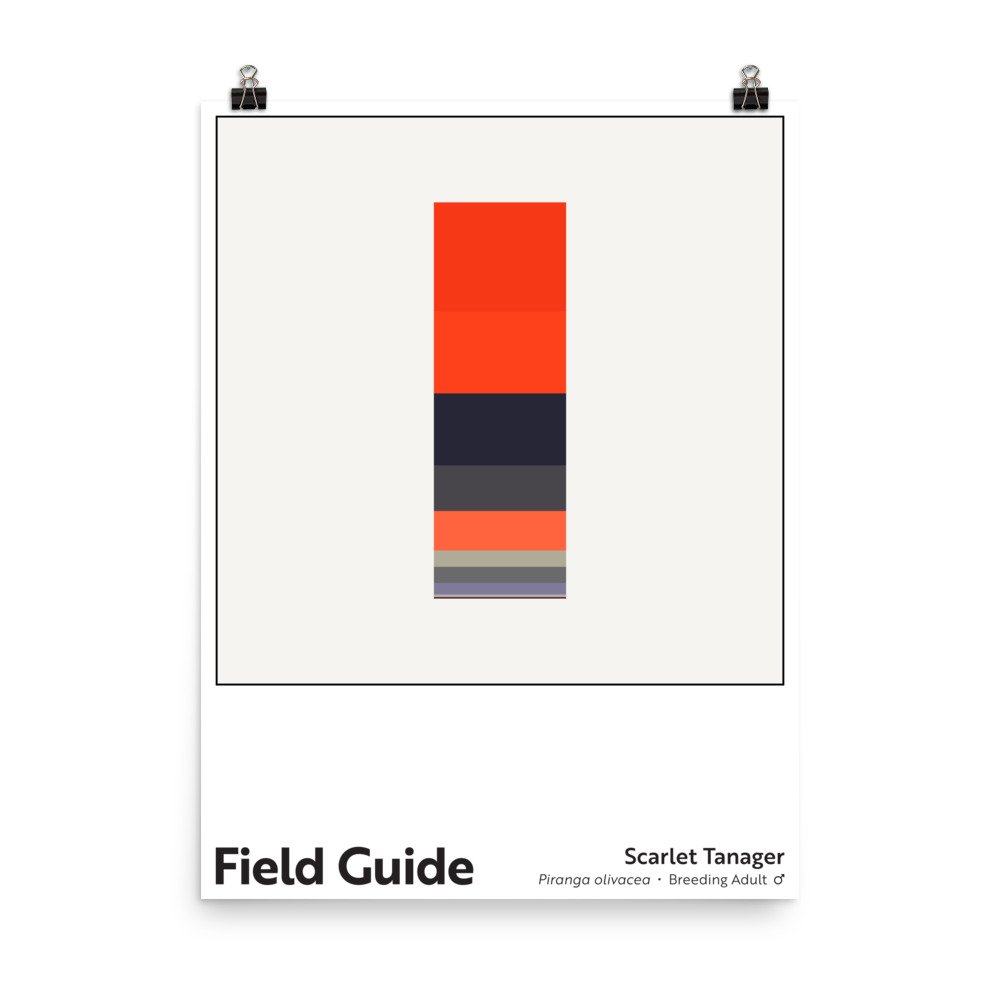 Image 1 of 2
Image 1 of 2

 Image 2 of 2
Image 2 of 2



Field Guide : Scarlet Tanager (Male)
Unlimited edition. 18 x 24 inch, museum-quality poster on matte paper.
Of the male scarlet tanager, Henry David Thoreau wrote, “you can hardly believe that a living creature wears such colors.” Indeed, when they’re dressed to impress, their scarlet, tomato, and salmon feathers boldly contrast with rich darks, making these passerines among North America’s most visually arresting birds. The tanager “flies through the green foliage as if it would ignite the leaves,” Thoreau exalted.
When explaining bird migration to someone unfamiliar with the concept – kids, especially – scarlet tanagers are a helpful and representative case. Once someone understands that scarlet tanager fellas look totally different in the late spring and summer than they do in winter (when they’re basically indistinguishable from the olive-yellow tanager gals), it’s easier for that person to look at a map or globe and appreciate the fact that, in a very general sense, the males are red during the summer in North America, olive-yellow during the winter in South America, and transitioning (molting) just before they pass through Central America coming and going. When they get this simplified take, other differences can be introduced. Diet, for example: when the male tanagers are breeding in North America’s midwestern and eastern forests, their diet is almost exclusively composed of insects 🦟, but when they return to the montane forests of Colombia, Ecuador, Peru, and Bolivia, fruit makes up a significant portion of their menu. 🍒
Note: These archival poster prints feature rich, appealing colors. I encourage customers to take care in handling them until they are framed/protected for display; the darker colors on the matte paper can be scratched. They ship rolled, so customers need to flatten them before framing (or have their framer do so).
Charitable Sales Model: Whenever one of these poster prints is purchased, a charitable contribution equal to 10% of the print’s cost (or $3.60) is made to a nonprofit working to tackle environmental or social challenges. Read more about my charitable sales model here.
Unlimited edition. 18 x 24 inch, museum-quality poster on matte paper.
Of the male scarlet tanager, Henry David Thoreau wrote, “you can hardly believe that a living creature wears such colors.” Indeed, when they’re dressed to impress, their scarlet, tomato, and salmon feathers boldly contrast with rich darks, making these passerines among North America’s most visually arresting birds. The tanager “flies through the green foliage as if it would ignite the leaves,” Thoreau exalted.
When explaining bird migration to someone unfamiliar with the concept – kids, especially – scarlet tanagers are a helpful and representative case. Once someone understands that scarlet tanager fellas look totally different in the late spring and summer than they do in winter (when they’re basically indistinguishable from the olive-yellow tanager gals), it’s easier for that person to look at a map or globe and appreciate the fact that, in a very general sense, the males are red during the summer in North America, olive-yellow during the winter in South America, and transitioning (molting) just before they pass through Central America coming and going. When they get this simplified take, other differences can be introduced. Diet, for example: when the male tanagers are breeding in North America’s midwestern and eastern forests, their diet is almost exclusively composed of insects 🦟, but when they return to the montane forests of Colombia, Ecuador, Peru, and Bolivia, fruit makes up a significant portion of their menu. 🍒
Note: These archival poster prints feature rich, appealing colors. I encourage customers to take care in handling them until they are framed/protected for display; the darker colors on the matte paper can be scratched. They ship rolled, so customers need to flatten them before framing (or have their framer do so).
Charitable Sales Model: Whenever one of these poster prints is purchased, a charitable contribution equal to 10% of the print’s cost (or $3.60) is made to a nonprofit working to tackle environmental or social challenges. Read more about my charitable sales model here.